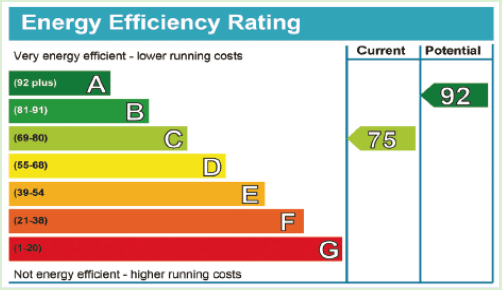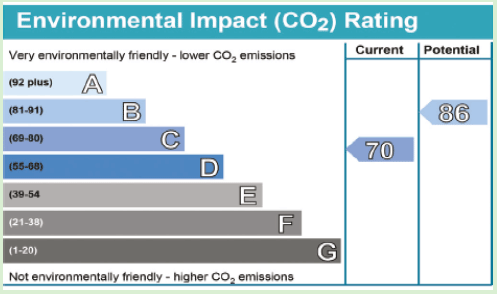Improving energy efficiency in owner occupied homes: consultation
This consultation seeks views on proposals to set a standard for energy efficiency and to make it mandatory for homeowners from 2024 onwards.
Annex A: Energy Performance Certificates
What are Energy Performance Certificates?
Energy Performance Certificates (EPCs) provide information on how energy efficient your building is, and how it could be improved. Buildings are rated on a scale from A-G, with A being the most efficient. Information is also provided on measures which could be made to improve the energy efficiency and an indication of the cost for each improvement.
An EPC must be produced when a new building has been constructed; and when a building is to be sold or rented to a new tenant. An EPC must also be obtained and displayed in a building over 250m2 in area, which is occupied by a public authority and frequently visited by the public.
EPCs are valid for 10 years. They are based on information such as the size and layout of a building, how it has been constructed and the way it is insulated, heated, ventilated, and lighted. Since people use buildings in different ways, the calculation is based on standardised assumptions of occupancy and use.
What do domestic EPCs show?
Domestic EPCs display an Energy Efficiency Rating (EER) and an Environmental Impact Rating (EIR). The EER is rated in terms of energy costs, while the EIR is rated in terms of carbon emissions. Domestic EPCs also have numerical ratings, with a higher number suggesting greater energy efficiency.
On an EPC the numbered arrows show the current rating based on the existing energy performance of the property and the potential rating if the suggested improvements are implemented. An EPC also shows the Primary Energy Indicator which is based on the kWh of energy use per square metre.


The EER is the most widely recognised rating on an EPC. The EER is based on costs, so varies by energy supply rather than just fabric performance. The EIR rates the environmental impact of a property by measuring a property's impact on the environment in terms of carbon dioxide (CO2) emissions.
Both EER and EIR are relevant given the dual objective of Energy Efficient Scotland in eliminating poor energy efficiency as a driver of fuel poverty and reducing greenhouse gas emissions.
The Primary Energy Indicator is based on the annual kWh energy use per square metre. This indicator varies by energy supply as it takes into account energy lost in generation, transmission and distribution. However the current layout of the EPC does not offer a way of indicating and interpreting that figure into energy efficiency and environmental impact values that would be understandable for most homeowners.
A potential issue with basing EES targets on the EER, is the higher fuel costs in Standard Assessment Procedure[18] (SAP) for some renewable and low carbon heating sources. In some scenarios using SAP methodology, moving from a higher efficiency gas boiler to a heat pump powered by electricity would result in a worsening of the EER.
This would mean in those particular scenarios, replacing gas boilers with heat pumps might reduce the EER, with a consequence that a property might not meet the standard. Using SAP methodology in those scenarios would also reduce the EIR rating due to the current higher SAP emissions values for electricity.
The current SAP emissions values do not yet not reflect the decreased emissions associated with electricity. This is problematic as installing heat pumps will make an important contribution in meeting our climate change targets. However, SAP values may change in the near future.
Future versions of SAP may improve the emissions factor of electricity as well the primary energy factor. This is due to environmental improvements and decreased emissions associated with the continuing decarbonisation of the electricity supply to the National Grid. This will help technologies such as heat pumps contribute to achieving climate change targets in the future.
As a result of any changes to SAP, there may be a need for the long term EES standard to be flexible and reviewed at specific points in the future.
Any review of the standard could also take into account other issues that may affect whether properties meet the standard, such as the development of the energy supply in the short to medium term including any possible UK Government announcements on hydrogen and the re-provisioning of the gas network.
We intend to use this consultation to consider whether the long term EES standard should be flexible and reviewed at specific points in the future or whether the standards should be fixed in the regulations from the outset (see Question 6).
In the medium to long term, with uncertainties around the timescales for changes to fuel costs and emissions for electricity in SAP and the future technology mix for heat decarbonisation, there may be merit to initially focusing the owner occupier regulations on improving the building fabric as much as possible. This would help both those living in fuel poverty and in reducing emissions.
Alongside the fabric first approach, in order to incentivise low carbon and renewable heat sources such as district heating and heat pumps, or facilitate those who wish to decarbonise their heating supply, we are proposing an abeyance for those properties which install heat pumps or connect to district heating but do not meet the EPC band C target based on the EER.
There may be an opportunity to develop guidance to accompany the regulations which could outline any heating technologies and/or district heating that would be eligible for abeyances. We would expect in those scenarios that the majority of building fabric improvements will have already been made to a property where technically feasible and cost effective.
Finally, where a property does not meet the EPC band C standard by the installation of any measures to improve EER, there may be potential to introduce a requirement that the EIR is not made worse following the installation of those measures.
Contact
Email: leeanne.mullan@gov.scot
There is a problem
Thanks for your feedback